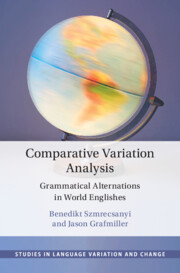Book contents
- Frontmatter
- Dedication
- Contents
- List of Figures
- List of Tables
- Series Editor’s Preface
- Acknowledgments
- Data Availability Statement
- 1 Introduction
- 2 Grammatical and Syntactic Variation
- 3 World Englishes and Dialect Typology
- 4 The Data
- 5 Alternation-by-Alternation Analysis
- 6 Distances, Similarities, and Coherence
- 7 Experimental Corroboration
- 8 Where Are We Now, and Where to Next?
- References
- Index
6 - Distances, Similarities, and Coherence
Published online by Cambridge University Press: 24 August 2023
- Frontmatter
- Dedication
- Contents
- List of Figures
- List of Tables
- Series Editor’s Preface
- Acknowledgments
- Data Availability Statement
- 1 Introduction
- 2 Grammatical and Syntactic Variation
- 3 World Englishes and Dialect Typology
- 4 The Data
- 5 Alternation-by-Alternation Analysis
- 6 Distances, Similarities, and Coherence
- 7 Experimental Corroboration
- 8 Where Are We Now, and Where to Next?
- References
- Index
Summary
This chapter is inspired by work in comparative sociolinguistics and quantitative dialectometry. We use a corpus-based method (Variation-Based Distance and Similarity Modeling – VADIS for short) to quantify the similarity between, and coherence across, the varieties of English under study as a function of the correspondence of the ways in which language users choose between different ways of saying the same thing. Key findings include the result that probabilistic grammars are remarkably stable across varieties but that coherence across alternations is not perfect.
Keywords
- Type
- Chapter
- Information
- Comparative Variation AnalysisGrammatical Alternations in World Englishes, pp. 112 - 140Publisher: Cambridge University PressPrint publication year: 2023

